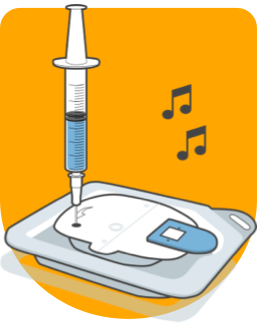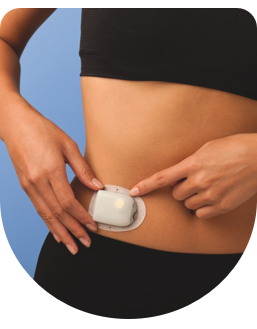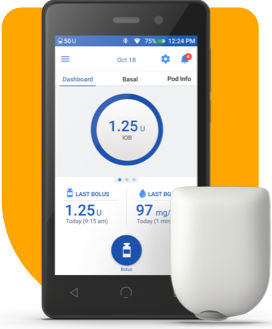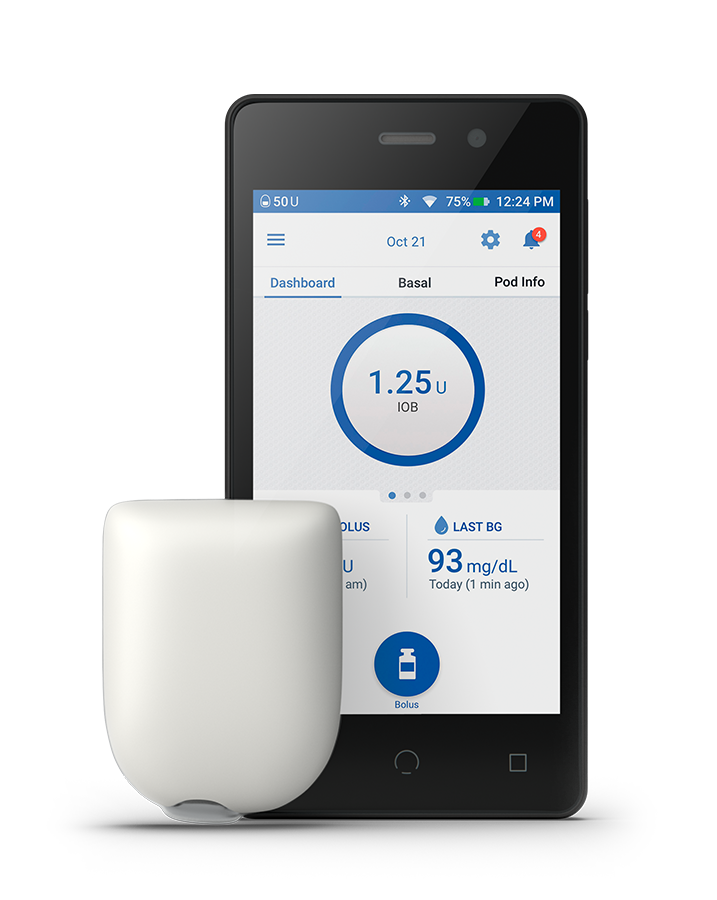Do You Have Type 2 Patients like Kelly That are Struggling to Achieve Targets with MDI?
Meet Kelly!
Clinical Overview
Age: 58 years old
Diagnosis: Type 2 Diabetes for 14 years
HbA1c: >9% and not improving
BMI: 34
Current Insulin Therapy
- Long-acting insulin at night & short-acting insulin before meals
- Insulin TDD: 105 units
Actionable Insights
- Tries to adhere to prescribed insulin regimen, but admits to occasionally missing doses
- Overwhelmed with diabetes management
- HbA1c not a goal despite titration
- Recently started using a CGM and opened her eyes to glucose swing throughout the day
The First Tubeless Full-featured Insulin Delivery System, Omnipod DASH®
The Solution For You and People Just Like Kelly!
Simplicity
Control
Time
Did You Know?
The majority of HCPs believe that the Omnipod DASH System improves adherence to pump therapy and quality of Life (QoL) among people with Type 2 diabetes switching from basal- bolus.2,3
Insulin Delivery in 3 Simple Steps
With a Tubeless, Discreet and Wearable Technology


Fill the Pod with rapid acting insulin and place it almost anywhere insulin can be administered


Automatically insert the cannula and begin personalized basal insulin delivery without seeing or handling the needle


Start insulin delivery with personalized basal insulin delivery, Bolus and Custom Food presets to simplify meal time insulin
Control
Proven Clinical Outcomes5
Adults experienced a significant reduction in HbA1c, Total Daily Dose & Hypoglycemic events after only 3 months of Omnipod® use in a retrospective study of 3,592 patients.5
Time
Spend more time treating and less time with paperwork, prescribe through the Pharmacy unlike traditional pumps
What This Means For You
-
No C-Peptide or BG logs required.
-
For the majority of Omnipod DASH® customers, the co-pay through the pharmacy channel is less than $50 per month.8
-
The average monthly patient out-of-pocket cost for the Omnipod DASH® System is lower than an MDI insulin delivery regimen.9
-
Omnipod DASH® System is covered by most plans, including commercial, Medicaid, and Medicare Part D, and available nationwide through retail pharmacies.10
-
Ease of electronic prescribing.
What This Means For Your Patients
-
No contract, obligation or high up-front costs
-
The average monthly patient out-of-pocket cost for the Omnipod DASH® System is lower than an MDI insulin delivery regimen.11
-
The Omnipod DASH® PDM is provided at no charge with a valid prescription
-
Pick up prescription from local pharmacy
Looking For Information Now?
Listen to this on demand webinar "Clinical Perspectives on Insulin-Requiring Patients with Type 2 Diabetes: Simplify Diabetes Care with Pod Therapy”.
No Additional Work For You or Your Practice.
The Omnipod Team is here to support you!
- Training and Follow-Up. Our Omnipod® Certified Clinicians will work with you and your patients to provide initial training and on-going support.
- Medical Questions. Click here!
- Customer Care Team. Is available for you and your patients 24/7 by 1-800-591-3455.
If you have any questions please call 1-800-591-3455 or visit Omnipod.com/HCP


Register for Omnipod® Connect!
Omnipod® Connect is designed to help HCPs learn more about Omnipod® products. We have developed several e-learning modules in bite-sized lessons, so you can learn about the System, familiarize yourself with best practices for initiation and get up to date with recent guidelines in diabetes technology for Type 1 and Type 2 insulin-requiring patients.
1. More than 69% of HCPs agree that Omnipod DASH® System simplifies diabetes care for patients living with diabetes. 140 HCPs were surveyed to gauge the practical experience of Omnipod® DASH® System use. Seagrove Partners, LLC, 2020
2. Based on the HCPs survey conducted in November 2020 by Seagrove Partners, LLC, 2020. 140 HCPs were surveyed to gauge the practical experience of Omnipod DASH® System use. 74% of HCP agreed that Omnipod DASH(R) System improves adherence among type 1 and type 2 patients.
3. Based on the HCPs survey, conducted in November 2020. 140 HCPs were surveyed to gauge the practical experience of Omnipod DASH® System use. Seagrove Partners, LLC, 2020.
4. Insulin Choice: U-100 short-acting insulins used for both basal and bolus insulin delivery. NovoLog®, Fiasp®, Humalog®, Admelog®, Lyumjev™, and Apidra® cleared for use within the Pod.
5. Carlson, AL et al. Improved Glycemic Control in 3,592 Adults with Type 2 Diabetes Mellitus Initiating a Tubeless Insulin Management System. Diabetes Res Clin Pr; 2021;174,108745:https://doi.org/10.1016/j.diabres.2021.108735 3,592 patients with Type 2 diabetes aged ≥18 years were included in a multisite, retrospective study based in the US. The study evaluated glycemic control and insulin use after three months of OmnipodR System and Omnipod DASHR System use, compared to prior treatment with MDI (74%), tubed insulin pumps (15%), and unknown (11%). HbA1c and TDD outcomes were from medical records or self-reported if medical records not available.
6. In HbA1c subgroup analysis, baseline vs. 3-month follow up HbA1c values were: <7%: 6.4% vs 6.6%; 7 to <8%: 7.5% vs. 7.2%; 8 to <9%: 8.4% vs. 7.7%; ≥9%: 10.8% vs. 8.5%, respectively.
7. The change in TDD is not -32 U due to decimal rounding.
8. Calculated based on a consumption of ten (10) Pods per month. Majority defined as at least 70% of patient co-pays under $50 per month. 131,049 paid claims between January 1st, 2020 and December 31st, 2020, both for commercial plans and Medicare, were analyzed. Actual co-pay amount depends on patient’s health plan and coverage, they may fluctuate and be higher or lower than the advertised amount on a monthly basis. Source: Data on file.
9. Estimated total monthly out-of-pocket for Omnipod DASH® System regimen is $72, versus $84 to $85 for MDI regimens. Omnipod DASH® System out-of-pocket cost based on the co-pay cost for rapid-acting insulin vial, Pods and alcohol wipes. MDI out-of-pocket cost based on the co-pay cost of rapid-acting and long-acting insulin vials (or LAI Pen and RAI Pen in the case of an MDI Pen regimen), alcohol wipes and syringes or needles (in the case of an MDI Pen regimen). MDI regimen co-pays based on 3 daily injections. All Omnipod DASH® estimates based off both commercial and Medicare paid claims between January 1st, 2020 and December 31st, 2020. Does not include any OOP related to CGM/BGM supplies. For illustration purposes only, actual co-pay amount depends on patient’s health plan and coverage. Source: Data on file
10. Exact coverage eligibility and restrictions vary by insurer and health plan. Exact retail pharmacy availability varies by geography.
11. The estimated total monthly out-of-pocket for Omnipod DASH® System regimen is $72, versus $84 to $85 for MDI regimens. Omnipod DASH® System out-of-pocket cost based on the co-pay cost for rapid-acting insulin vial, Pods, and alcohol wipes. MDI out-of-pocket cost based on the co-pay cost of rapid-acting and long-acting insulin vials (or LAI Pen and RAI Pen in the case of an MDI Pen regimen), alcohol wipes, and syringes or needles (in the case of an MDI Pen regimen). MDI regimen co-pays based on 3 daily injections. All Omnipod DASH® estimates based on both commercial and Medicare paid claims between January 1st, 2020, and December 31st, 2020. Does not include any OOP related to CGM/BGM supplies. For illustration purposes only, the actual co-pay amount depends on the patient’s health plan and coverage. Source: Data on file.